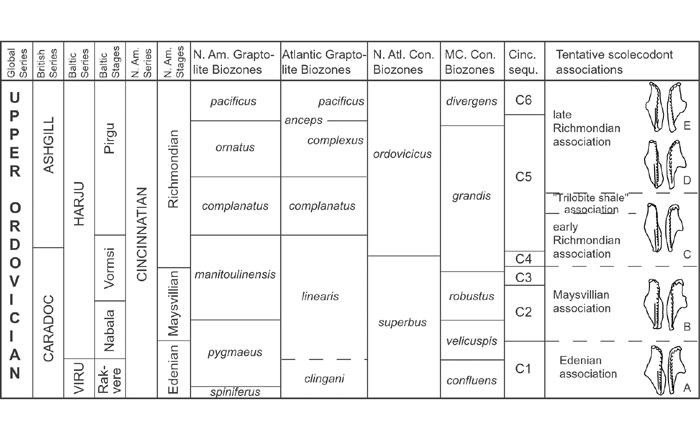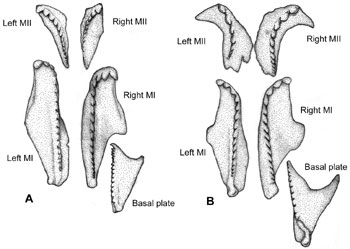
Late Ordovician polychaetaspid polychaete annelids from the type Cincinnatian region, USA
Mats Eriksson1
1 Department of Geology, University of Lund, Sölvegatan 13, SE–223 62 Lund, Sweden. E–mail: Mats.Eriksson@geol.lu.se
Key words: Scolecodonts. Polychaete jaws. Upper Ordovician. Type Cincinnatian. USA.
Introduction
The extinct polychaete annelid family Polychaetaspidae, known only from its jaws (scolecodonts) and jaw apparatuses, was erected by Kielan–Jaworowska (1966). These eunicidan polychaetes had jaw apparatuses of labidognath architecture, i.e., jaws arranged in a semi–circle when the apparatus was retracted, in some members comprising more than 20 individual (mainly paired) scolecodonts. Polychaetaspids are one of the most abundant and diverse jawed polychaete families in Early Paleozoic shallow marine strata and representatives are known from all present–day continents except for Antarctica. This paper reports preliminary results of an ongoing investigation on the polychaetaspids occurring in the Upper Ordovician of the type Cincinnatian region.
The type Cincinnatian region and its jawed polychaete faunas
The Cincinnatian Series (Upper Ordovician) is well exposed in its type region of the Indiana–Ohio–Kentucky tri–state area in the north–eastern U.S.A. The fossiliferous thin interbedded limestones and shales contain abundant and well–preserved scolecodonts that bear witness to rich jawed polychaete faunas inhabiting the shallow subtropical Late Ordovician sea in that area. Despite reaching abundances of over a thousand scolecodonts/kg of rock, these microfossils have been largely neglected in this region. An extensive collection of well over 50.000 well preserved scolecodonts from the Edenian through the latest Richmondian strata, embracing c. 10 Ma (Figure 1), forms the basis for this study (the bulk of the material is from localities exposing Richmondian strata). A long history of conodont and graptolite studies has resulted in a detailed biostratigraphic framework for various facies types in the type Cincinnatian region (Goldman and Bergström, 1997; Figure 1), to which the results of this study can be tied.
Some 40 to 50 jawed polychaete species, belonging to a dozen families, occur in the succession (Eriksson and Bergman, in press). The most common and characteristic genera are Oenonites Hinde, Kettnerites Zebera, Ramphoprion Kielan–Jaworowska, Protarabellites Stauffer, Atraktoprion Kielan–Jaworowska, Hinde, Kalloprion Kielan–Jaworowska, Leptoprion Kielan–Jaworowska, and Hadoprion Eriksson and Bergman, Mochtyella Kielan–Jaworowska, Tetraprion? Kielan–Jaworowska, and one genus of uncertain affinity. The polychaetaspids generally dominate both in terms of abundance and species richness. At least eight different species were identified of which seven were assigned to the genus Oenonites Hinde. One species (or a complex of species) is intermediate between that genus and Kozlowskiprion Kielan–Jaworowska. Various jaws of the polychaetaspid taxa occurring in the type Cincinnatian region have been described under single–element–based taxonomy in the older scolecodont literature (e.g., Hinde, 1879; Eller, 1942) and need to be revised. However, at least two of the identified species were previously undescribed.
In samples selected for statistical analyses, polychaetaspid scolecodonts comprise about 1–96%, commonly more than 50%, of the jawed polychaete faunas (based on counts of the first maxillae). Faunal diversity is generally low at each stratigraphic level; one or sometimes two species commonly dominate, and the maximum number of co–occurring polychaetaspid species observed is four. Gradually evolving lineages, with seemingly ancestral and descendant taxa, can be followed through the succession. The fairly short–ranging segments of these lineages have biostratigraphic potential, although possible ecological overprinting must be analyzed. Five tentative scolecodont associations were identified by Eriksson and Bergman (in press), each one housing at least one characteristic polychaetaspid taxon (Figure 1). The Edenian Kope Formation is dominated by O. cf. curvidens Hinde, which is succeeded by Oenonites sp. B, a taxon diagnostic of the Maysvillian Miamitown Shale. The latter species is closely similar to, and appears to be an intermediate between O. cf. curvidens Hinde and Oenonites sp. A (Figure 2A), a very common species in the superjacent Richmondian Arnheim and Waynesville formations. Oenonites sp. A is by far the most abundantly occurring taxon, with more than 21,000 isolated scolecodonts recovered, in the Richmondian part of the succession. It is the strongly dominant taxon in the basal part of the Waynesville Formation, forming up to almost 96% of the jawed polychaete fauna. The base of the Waynesville Formation coincides with the C4/C5 sequence boundary of Holland and Patzkowsky (1996), which is just above the base of the Amorphognathus ordovicicus Conodont Biozone (Figure 1; Goldman and Bergström, 1997). This level represents the maximum flooding surface, above which shaly strata were deposited during a presumably eustatic sea–level rise (Holland, 1993). The low taxonomic diversity and the strong dominance of Oenonites sp. A seem to reflect this deepening event, which may have caused a stressed environment for polychaetes.

Figure 1. Type Cincinnatian stratigraphy, graptolite, and conodont biostratigraphy modified from Eriksson and Bergman (in press), and originally based on Goldman and Bergström (1997) and S. M. Bergström (personal commun, Columbus, 2002). Cincinnati sequences (Cinc. sequ.) after Holland (1993) and Holland and Patzkowsky (1996). The tentative scolecodont associations are included with sketches of the first left and right maxillae (MI) of polychaetaspid species, characteristic to each association; A, Oenonites cf. curvidens Hinde; B, Oenonites sp. B; C, Oenonites sp. A; D, Oenonites aff. tuberosus (Eller); E, Oenonites marlenediesae (Eller). Note that Oenonites sp. A (C in figure) was identified in both the early Richmondian association and in the "Trilobite shale" association. Abbreviations; N. Am., North American; N. Atl., North Atlantic; MC, Midcontinent; Con., Conodont.

Figure 2. Drawings of reconstructed polychaetaspid jaw apparatuses (exploded) from the type Cincinnatian region. A. Oenonites sp. A, the most abundantly occurring polychaetaspid species in the type Cincinnatian region. B. Oenonites marlenediesae (Eller). This species is common in the late Richmondian Whitewater Formation at Caesar Creek Emergency Spillway and at Cowan Lake. M stands for maxilla.
In the late Richmondian Liberty, Whitewater, and Drakes strata at Caesar Creek and Cowan Lake, the polychaetaspid population is replaced and dominated by two characteristic species; O. marlenediesae (Eller) (Figure 2B) and O. aff. tuberosus (Eller) (Figure 1).
Due to the patchy documentation of Late Ordovician scolecodonts, it is only in the Baltic region that jawed polychaete faunas are known sufficiently well to warrant comparison (e.g., Kielan–Jaworowska, 1966; Hints, 2000; Hints and Eriksson, in press). The Baltic faunas provide an interesting contrast to those of North America, with conspicuous differences, particularly at the species level and in relative abundance patterns at supraspecific levels (Eriksson and Bergman, in press). Polychaetaspids are common to Baltica and Laurentia and both Oenonites Hinde, and Kozlowskiprion Kielan–Jaworowska, are widely distributed genera in Late Ordovician strata. At species level there are superficially similar polychaetaspids occurring on both sides of the Iapetus Ocean. However, only one type Cincinnatian species, tentatively assigned to O. tuberculatus (Eller), seems to occur also in Baltica.
Conclusions
This ongoing study revises historical papers and aims at excluding invalid and synonymous taxonomic names so that each taxon (based on a natural, multi–element–taxonomy) has one scientific name, e.g., Oenonites marlenediesae (Eller) (Figure 2B) was previously described under at least three different taxonomic names. This helps elucidate the diversity patterns and intercontinental distribution of the jawed polychaete faunas, without nomenclatural bias.
At least eight polychaetaspid taxa were identified, most of which have not been recorded in coeval strata of Baltica. The faunal associations identified in the type Cincinnatian region along with some rapidly evolving taxa, particularly species of Oenonites Hinde, indicate biostratigraphic utility.
Acknowledgements
Research funded by the Swedish Research Council (VR). Manuscript critically read and improved by Per Ahlberg, Euan N. K. Clarkson, and Olle Hints.
References
Eller, E.R. 1942. Scolecodonts from the Erindale, Upper Ordovician, at Streetsville, Ontario. Annals of the Carnegie Museum, 29: 240–270.
Eriksson, M. and Bergman, C.F. In press. Late Ordovician jawed polychaete faunas of the type Cincinnatian region, U.S.A. Journal of Paleontology.
Goldman, D. and Bergström, S.M. 1997. Late Ordovician graptolites from the North American Midcontinent. Palaeontology, 40: 965–1010.
Hinde, G.J. 1879. On annelid jaws from the Cambro–Silurian, Silurian and Devonian Formations in Canada and from the Lower Carboniferous in Scotland. Quarterly Journal of the Geological Society of London, 35: 370–389.
Hints, O. 2000. Ordovician eunicid polychaetes of Estonia and surrounding areas: review of their distribution and diversification. Review of Palaeobotany and Palynology, 113: 41–55.
Hints, O. and Eriksson, M. In press. Jawed Polychaetes. In: Webby, B.D., Paris, F. and Droser, M.L. (Eds.), The Great Ordovician Biodiversification Event, Columbia University Press.
Holland, S.M. 1993. Sequence stratigraphy of a carbonate–clastic ramp: The Cincinnatian Series (Upper Ordovician) in its type area. Geological Society of America Bulletin, 105: 306–322.
Holland, S.M. and Patzkowsky, M.E. 1996. Sequence stratigraphy and long–term paleoceanographic change in the Middle and Upper Ordovician of the eastern United States. In: Witzke, B.J., Ludwigsen, G.A. and Day, S. (Eds.), Paleozoic sequence stratigraphy: views from the North American Craton. Geological Society of America Special Paper, 306: 117–129.
Ludwigsen, G.A. and Day, J. (Eds.), Paleozoic sequence stratigraphy: views from the North American Craton. Geological Society of America Special Paper, 306: 117–129.
Kielan–Jaworowska, Z. 1966. Polychaete jaw apparatuses from the Ordovician and Silurian of Poland and comparison with modern forms. Palaeontologia Polonica, 16: 1–152.
Received: February 15, 2003
Accepted: June 15, 2003